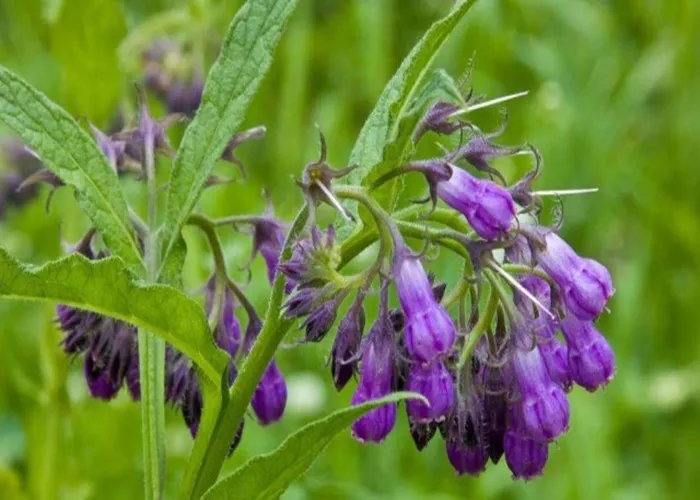Comfrey flowers are a delightful addition to any garden, known for their unique appearance and medicinal properties. As a plant expert, I will provide a detailed introduction to comfrey flowers, describe their appearance, and explain their characteristics in a logical and coherent manner using simple sentences.
What Is Comfrey Flowers
Comfrey, scientifically known as Symphytum officinale, belongs to the borage family (Boraginaceae). It is a perennial herb native to Eurasia, characterized by its large, hairy leaves and drooping clusters of small flowers. The plant has been used for centuries in herbal medicine due to its healing properties.
Characteristics of Comfrey Flowers
1. Shape and Size
Comfrey flowers are small and bell-shaped, adding a delicate touch to the garden. The flowers are typically about 1 to 2 centimeters in diameter, making them a charming sight when they cluster together.
2. Color
Comfrey flowers come in various shades, including blue, purplish-pink, and white. The flowers often have a two-tone appearance, with the upper petals being a lighter shade and the lower petals a darker color. This color variation adds to the plant’s visual appeal.
3. Leaf Structure
The leaves of comfrey plants are large and hairy, with a lance-shaped appearance. They can grow up to 30 centimeters in length and are covered in tiny hairs that give them a slightly rough texture. The leaves are arranged in a basal rosette, meaning they grow close to the ground at the base of the plant.
4. Flower Arrangement
Comfrey flowers are arranged in drooping clusters, known as cymes. These clusters can contain numerous flowers, creating a full and lush appearance. The flowers are typically pendulous, meaning they hang downward, adding a graceful element to the plant.
Detailed Description of Comfrey Flowers
1. Petals and Sepals
Comfrey flowers have five petals that are fused at the base, forming a bell-shaped structure. The petals are delicate and thin, with a smooth texture. The sepals, which are the green, leaf-like structures that protect the flower buds, are also fused at the base and are often hairy.
2. Reproductive Structures
Inside the bell-shaped flowers, you will find the reproductive structures of the plant. The stamens, which produce pollen, are located in the center of the flower. The stigma, which receives pollen, is at the top of the flower, making it easy for pollinators to access.
3. Pollination
Comfrey flowers rely on pollinators, such as bees and butterflies, to spread their pollen and facilitate reproduction. The flowers’ bell-shape and bright colors attract pollinators, ensuring the plant’s success in reproduction.
Growing Comfrey Flowers
1. Soil and Water Requirements
Comfrey plants thrive in well-drained soil that is rich in organic matter. They prefer full sun to partial shade and require consistent moisture, especially during the growing season. Water the plants regularly to keep the soil moist but not waterlogged.
2. Propagation
Comfrey can be propagated through division or seeds. Division is the most common method, as it allows you to create new plants from an existing one. Simply dig up the plant in the spring or fall, divide the root ball into sections, and replant the sections in a new location. Seeds can be started indoors in the early spring and transplanted outdoors once they have germinated.
3. Care and Maintenance
Comfrey plants are relatively low-maintenance once they are established. Remove any dead or yellowing leaves to keep the plant healthy and encourage new growth. Prune the flowers if desired to maintain a neat appearance or to encourage more flowering.
Medicinal Uses of Comfrey Flowers
Comfrey flowers and leaves have been used in herbal medicine for centuries due to their healing properties. The plant contains allantoin, a compound that stimulates cell growth and helps heal wounds. However, it is important to note that comfrey should not be ingested internally due to potential liver toxicity.
1. External Uses
Comfrey can be used externally to treat various skin conditions and wounds. It can be made into a poultice or infused into oil for topical application. The leaves and flowers can also be used in herbal teas for external use, such as foot soaks or compresses.
2. Warnings
Due to the potential toxicity of comfrey when ingested internally, it is essential to use it only externally and in moderation. Consult with a qualified herbalist or healthcare provider before using comfrey for medicinal purposes.
Conclusion
Comfrey flowers are a beautiful and beneficial addition to any garden. Their bell-shaped flowers in shades of blue, purplish-pink, and white add a charming touch to the landscape. The plant’s medicinal properties make it a valuable resource for treating wounds and skin conditions when used externally. With proper care and maintenance, comfrey plants can thrive and provide years of enjoyment and healing benefits.
In summary, comfrey flowers are a delightful garden addition with unique characteristics and numerous benefits. By understanding their appearance, growth requirements, and medicinal uses, you can fully appreciate and enjoy this versatile plant. Whether you are a seasoned gardener or a beginner, comfrey flowers are sure to bring joy and beauty to your outdoor space.
Related topics:
- What Do Moonflowers Look Like? A Comprehensive Guide
- Exploring the Moon Flowers: Appearance, Cultural Significance & Symbolism
- How Sunflowers Bloom Under Moonlight?


